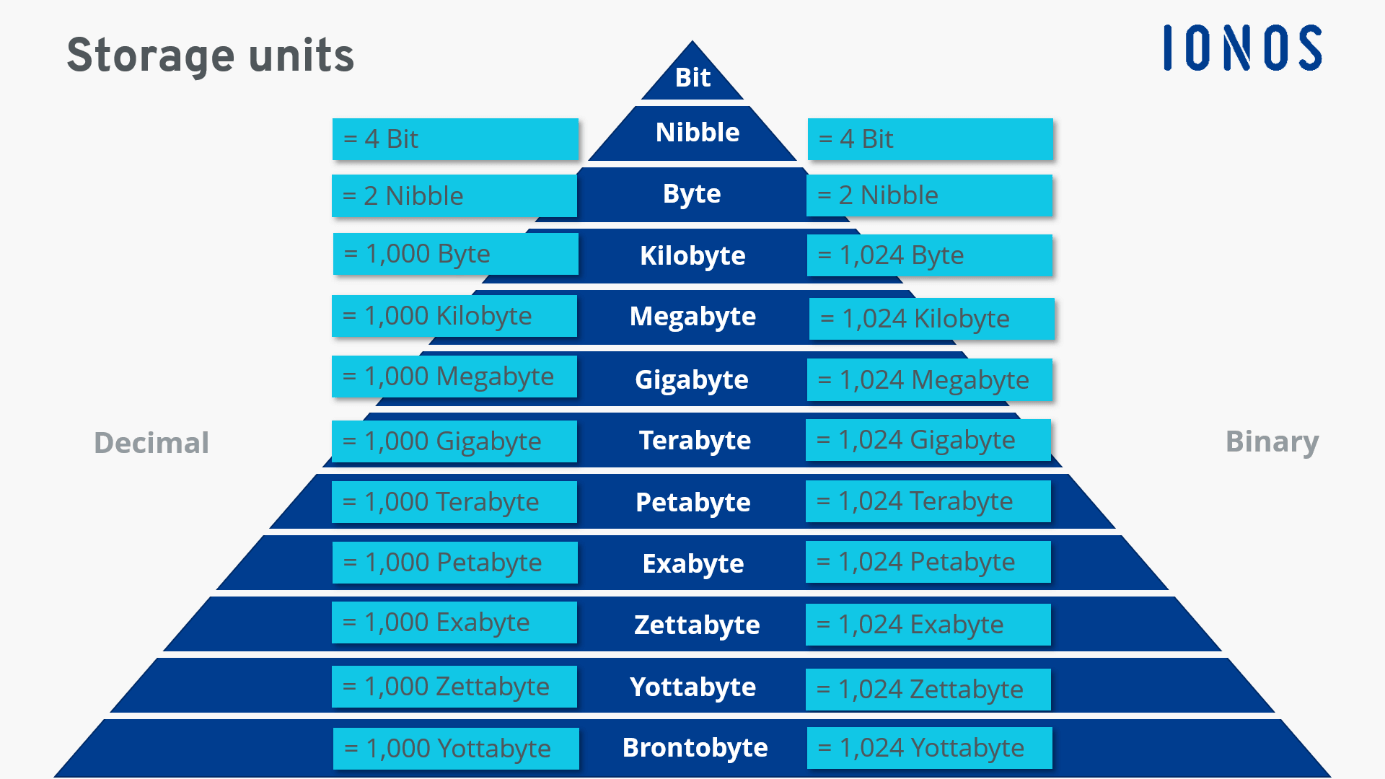
Navigating the Digital Landscape: Understanding Data Storage and Conversion
In today's digital age, we are constantly surrounded by data. From the photos we take on our smartphones to the massive databases that power our online experiences, data is the lifeblood of the modern world. But have you ever stopped to consider how this data is measured and stored?
This article delves into the fascinating world of data storage, exploring the fundamental units of measurement and the conversions between them. We'll journey from the minuscule byte to the colossal petabyte, providing you with a clear understanding of how these units relate to each other and the real-world implications of their sizes.
The Building Blocks of Data: Bits and Bytes
At the heart of all digital information lies the bit, the smallest possible unit of data. A bit can exist in only two states: 0 or 1, representing the on or off state of an electrical switch within a computer. While incredibly simple, these bits are the foundation upon which all our complex digital systems are built.
To represent more meaningful information, bits are grouped together into bytes. A single byte consists of 8 bits, providing enough combinations to represent letters, numbers, symbols, and other data types. The byte serves as the fundamental building block for measuring data storage capacity.
Scaling Up: Kilobytes, Megabytes, Gigabytes, and Beyond
As we move beyond the byte, we encounter larger units of measurement that help us quantify the vast amounts of data we generate and consume daily. These units follow a familiar pattern, with each successive unit representing 1024 (2^10) of the previous unit:
- Kilobyte (KB): 1,024 bytes. Think of a short email or a simple text document.
- Megabyte (MB): 1,024 kilobytes. This is roughly the size of a high-resolution photograph or a song in MP3 format.
- Gigabyte (GB): 1,024 megabytes. This is the typical size of a movie file, a video game, or a small solid-state drive (SSD).
- Terabyte (TB): 1,024 gigabytes. This is the capacity of many modern hard disk drives (HDDs), capable of storing vast libraries of movies, music, and other data.
- Petabyte (PB): 1,024 terabytes. This is the realm of massive datasets used by scientific research institutions and large corporations.
- Exabyte (EB): 1,024 petabytes. This is the scale of data generated by global internet traffic over a period of time.
- Zettabyte (ZB): 1,024 exabytes. This is a truly astronomical amount of data, exceeding the estimated total amount of digital data created globally in 2020.
- Yottabyte (YB): 1,024 zettabytes. This is the largest currently defined unit of data storage, representing an almost unimaginable quantity of information.
Data Storage in Action: Real-World Examples
To better grasp the scale of these units, let's consider some real-world examples:
- A single typed page: Approximately 2 KB
- A high-resolution photograph: 5-10 MB
- A 4-minute song in MP3 format: 4-5 MB
- A full-length HD movie: 4-8 GB
- A modern video game: 50-100 GB
- A typical smartphone: 128-512 GB
- A laptop hard drive: 1-4 TB
- Global internet traffic per month: Several exabytes
Converting Between Units: A Simple Guide
Converting between different data storage units is a straightforward process, involving multiplication or division by 1024. For instance, to convert from megabytes to gigabytes, you would divide the number of megabytes by 1024. Conversely, to convert from gigabytes to megabytes, you would multiply the number of gigabytes by 1024.
While manual calculations are feasible, numerous online tools and calculators can simplify this process. These resources provide quick and accurate conversions between various units, saving you time and effort.
Helpful Conversion Tools:
- Google Search: Simply type your conversion query into Google (e.g., "1024 MB to GB") to get an instant answer.
- Online Conversion Websites: Websites like ConvertUnits.com and CalculatorSoup.com offer comprehensive conversion tools for various units, including data storage.
Beyond the Basics: Understanding Data Storage Technologies
While bits and bytes provide the foundation for measuring data, the actual storage of this data relies on various technologies, each with its own characteristics and applications. Some common data storage technologies include:
- Hard Disk Drives (HDDs): These traditional storage devices use spinning platters and magnetic heads to read and write data. HDDs offer large storage capacities at relatively low costs but can be slower and more susceptible to damage than other technologies.
- Solid-State Drives (SSDs): These newer storage devices use flash memory to store data, offering significantly faster read and write speeds and improved durability compared to HDDs. However, SSDs generally come with higher price tags.
- Cloud Storage: This increasingly popular option stores data on remote servers accessed via the internet. Cloud storage offers scalability, accessibility, and data redundancy but can be dependent on internet connectivity and raise privacy concerns.
The Future of Data Storage: Emerging Trends
The field of data storage is constantly evolving, with new technologies and trends emerging to address the ever-growing demands of our digital world. Some key trends to watch include:
- DNA Storage: This groundbreaking technology utilizes synthetic DNA molecules to store vast amounts of data in an incredibly compact and durable format. While still in its early stages, DNA storage holds immense potential for long-term archival and data preservation.
- Quantum Storage: Leveraging the principles of quantum mechanics, this technology aims to revolutionize data storage by offering unprecedented storage densities and processing capabilities.
- Neuromorphic Computing: Inspired by the human brain, this approach seeks to integrate data storage and processing, potentially leading to more efficient and intelligent data management systems.
Conclusion
Understanding data storage and conversion is essential for navigating the digital landscape. By grasping the fundamental units of measurement and the relationships between them, you can make informed decisions about your data storage needs and appreciate the vast scale of information that surrounds us. As technology continues to advance, staying informed about emerging trends in data storage will be crucial for harnessing the full potential of our increasingly data-driven world.